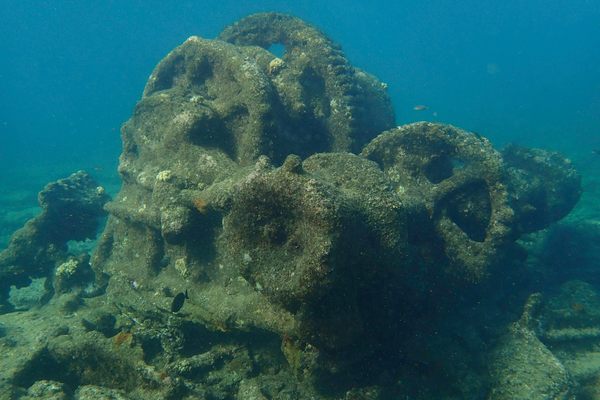These Intrepid Surfers Chill Out Riding the Great Lakes’ Wintry Waves
Stressing the need for proper gear and training, members of this close-knit community say their sport gets them through the long, cold season.
Icy wind rolls off the shores of Lake Ontario, blowing past rows of pines and naked birches and reeling through the deserted streets of Rochester, New York. Most of the city’s inhabitants are hunkered down in the warmth of their homes, preparing for an imminent storm. Aurelien Bouche-Pillon, however, is preparing to go surfing.
Born in the coastal French city of Biarritz, Bouche-Pillon says he came to America “with a surfboard and a backpack.” He moved to Rochester for a girlfriend, but found himself feeling low during the long winters, when he fantasized about California’s waves. Then, in 2006, Hurricane Ernesto flew up the coast and barreled into New York State.
Bouche-Pillon’s thoughts turned to Lake Ontario. “I’m thinking, with this body of water and those winds—if I’m in the right place at the right time, there must be a wave somewhere,” he says. He drove along the shore, through the storm, until he found a pier by a stony beach.
He wasn’t alone. Two men were already out on the lake, riding the eight-foot-plus waves drummed up by the hurricane. Bouche-Pillon had brought only a wetsuit, no surfboard, so he borrowed one and caught a wave. “That was the beginning of a long journey,” he says
Surfing had kept him out of trouble in his youth, but the freezing lakes elevated the sport. “There is something very special and very spiritual about the cold water,” he says. “It cleans the mind and body.”

Bouche-Pillon is part of a growing number of surfers who venture out onto the Great Lakes in winter’s extreme weather, sometimes braving sub-zero temperatures and snow squalls in pursuit of adrenaline, catharsis, and an escape from seasonal blues. Surfing in general has been shown to improve mental well-being, and surf therapy is becoming increasingly popular; for the properly prepared, catching a wave along the edges of North America’s vast inland seas may be particularly beneficial during the long Midwest winter.
When Lake Erie-based surfer Sam Macsai moved to Ontario from her native Australia, she found herself homesick, missing the sunshine, and unable to escape cycles of negative thoughts. Everything changed, she says, when “somebody told me that you could actually surf here.” She went on to cofound a surf school called Saltless Surf, where she introduces people to the freshwater waves. “When you’re in the pocket of a wave,” she says, “it’s like nothing else in the entire world matters.”
While surfers can be spotted exploring the lakes year round, wave conditions tend to be better in the winter, due in part to stronger winds. Also, “hot air rises, and cold sinks,” says Lake Michigan surfer Jamie Walter. Like a hand pushing down on the water, he says, the cold air pushes down on the lake and whips up the waves. Walter often surfs the lake’s lighthouse-studded shores with his 11-year-old son Jameson, who started surfing here when he was six—and now has both an Instagram following and sponsorship from Michigan’s Third Coast Surf Shop.
The lakes’ waves tend to be smaller and choppier than on the ocean, and fresh water is less buoyant than salt water, which means lake surfers tend to spend more time in the water than gliding on its surface. For winter lake surfing in particular, proper gear is critical, including thicker wetsuits, gloves, and boots. Hypothermia is a significant risk: Without appropriate protective gear, surfers could lose consciousness in a matter of minutes. The senior Walter takes extra precautions with Jameson, applying petroleum jelly to exposed skin and dumping warm water down their wetsuits for a little extra heat before, during, and after their sessions.

Guy Meadows, founding director of the Great Lakes Research Center at Michigan Technical University, high on the state’s Upper Peninsula, says surfing can be “great fun for the select few” prepared for it. He notes that, in late 2022, waves reached heights of 21 feet on nearby Lake Superior. But, he adds, even “a moderately small wave, 39 inches tall and moving at a substantial speed, is like getting hit by a Volkswagen.”
Despite the extreme conditions and very real dangers of the Great Lakes in winter, the “select few” Meadows mentions are also a safe bunch. St. Louis County Sheriff’s Lieutenant Todd Abernathy, whose jurisdiction bumps up against Lake Superior’s western edge in Minnesota, says he’s “never heard of a call” about a surfing accident. The region’s winter surfers tend to police themselves and agree that, says surfer Dave Benjamin, “Winter is not the time to try to come out and learn how to surf.” In addition to being a surfer, Benjamin is a cofounder of the Great Lakes Surf Rescue Project (GLSRP), a Lake Michigan-based volunteer organization that promotes water safety. The “surf rescue” part of GLSRP’s name refers to the water and not surfers who need rescue. In fact, since the organization began tracking drowning incidents across all five lakes in 2010, there have been no surfing-related deaths in any season.
While rogue waves, rip currents, and other dangerous conditions can occur on the lakes year round, in winter just getting to the water can be the most treacherous part of the surfing experience thanks to icy roads and blizzard conditions. To find the perfect wave, serious surfers may spend hours scouring wind and swell reports, exchanging data in group chats, or trawling Google Earth in search of promising inlets and jetties that could foster big waves. They sometimes drive hundreds of miles to their chosen spot only to discover the lake is stuffed with pumpkin-sized chunks of ice—or worse, smooth as glass.
But sometimes conditions are just right, leading to an experience that many of the surfers who venture out on the Great Lakes say approaches transcendence. Bouche-Pillon remembers a moment at his favorite, secret spot, when a massive wave came out of nowhere and washed the entire beach in white foam, followed by a surreal silence. Macsai recalls a particularly sublime moment surfing Lake Ontario, watching lightning bolts land on the lake’s horizon as snow fell. Her favorite winter surf spot is off a little Lake Erie town called Crystal Beach, which overflows with vacationers in summer. In winter, however, only snow-covered campsites, abandoned water parks, and rows of empty cabins—along with the occasional intrepid hawk—watch her as she surfs.
Despite the isolation many Great Lakes winter surfers experience on the water, they find camaraderie either online, at regional, year-round surf shops, or at competitions and beach clean-up days. Connections in the small, close-knit group run deep: When a community member dies, surfers will often hold paddle-outs, gathering in a circle out on the water to honor their departed friend. Bouche-Pillon says he hopes the Great Lakes surf community will host a paddle-out for him one day. But for now, despite the gathering snow and howling wind outside, he’s itching to get to the lake.
“There’s something therapeutic and exciting about the cold, when you are out there on a stormy lake, and you see the movement of the water and feel the wind and the snow and you catch a big wave,” he says. “I wouldn’t wish to be anywhere else.”

















Follow us on Twitter to get the latest on the world's hidden wonders.
Like us on Facebook to get the latest on the world's hidden wonders.
Follow us on Twitter Like us on Facebook